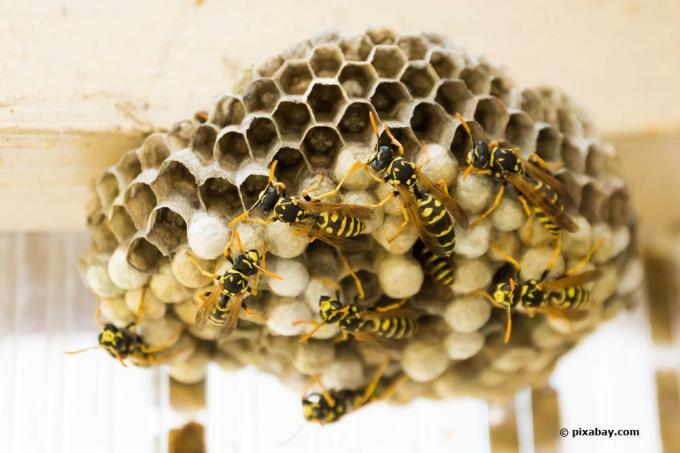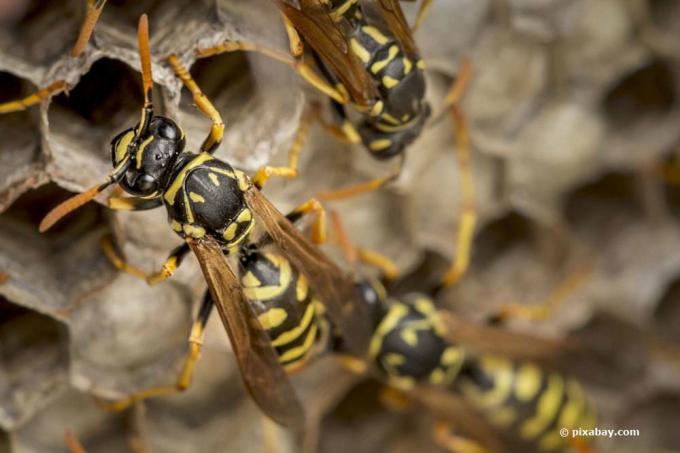
table of contents
- Do wasps survive the winter?
- Hibernate: expiry
- 1. Young queens leave the nest
- 2. Fertilization and winter quarters
- 3. Numbness
- 4. Old Queen & Die Colony
- 5. New establishment of the wasp state
Despite their importance to nature, wasps are among the greatest troublemakers for many people. The insect hunters draw attention to themselves, especially towards the end of summer, when they dare to get closer and closer to people's food because their own food sources are dwindling. If a wasp's nest is also found, the quiet is usually over. Whoever wants to remove this wonders whether the wasps hibernate like bees in the nest or not.
Do wasps survive the winter?
A big difference between bees and the species of the subfamily Vespinae is the type of overwintering. While bees use their beehives as winter quarters during the cold season, the state disappears completely with the wasps. Bee colonies form so-called winter clusters with the queen in the middle. Whereas young wasp queens leave the wasp nest before winter and look for shelter until the new year. The rest of the tribe and the old queen die and the nest can be left to humans over the winter months
without permissionremoved will. The dissolution of the state is carried out by all wasp species that occur in Germany.Yes, even hornets follow the same annual cycle as the other wasp species. Since the Vespa is a larger, more peaceful variant, many people forget that this is the same family. That means, regardless of whether you find a hornet or wasp nest, they will all have dissolved by the onset of winter. Depending on the species, however, the young queens may return to the same nesting site in the next year, as they prefer certain locations. This is especially the case with field wasps. When a wasp state dissolves, however, depends on many factors, which are explained in detail below.

tip: Even the cuckoo wasps, including the mountain wasp cuckoo wasp (Polistes atrimandibularis), wrong Cuckoo wasp (Dolichovespula adulterina) and Austrian cuckoo wasp (Vespula austriaca) dissolve at the latest in Fall on. On average, the lifespan of these colonies is even shorter.
Hibernate: expiry
The hibernation and simultaneous dissolution of the wasp state does not happen overnight. When summer draws to a close, a carefully planned process occurs that is related to the natural life of the animals. The following steps explain this process in detail:
1. Young queens leave the nest
The dissolution of the wasp state before winter begins, depending on the wasp species, as early as mid-August and lasts until the beginning of mid-October. That depends on the outside temperature, because this determines the time of the mating of the young queens, whose departure heralds the "downfall" of the nest. With the exception of the following four wasp species, the young queens leave their colonies in mid to late August:
- German wasp (Vespula germanica)
- Common wasp (Vespula vulgaris)
- Hornet (Vespa crabro)
- Asiatic hornet (Vespa velutina var. nigrithorax)
For these, the move-out does not begin until the middle to the end of September.
2. Fertilization and winter quarters
Immediately after moving out, the young queens are followed by the drones, i.e. the male animals, as these are necessary for fertilization. In the state itself, only the workers and the old queen remain, who do not hibernate but die over the winter.
After fertilization of the young queens, the drones die over a course of several weeks, but do not return to the wasp nest. The queens can even be fertilized several times and then look for sheltered quarters for the winter. This can be, for example, pieces of bark, piles of wood or holes in the ground that have a stable microclimate that is only exposed to minor fluctuations. Attics and roller shutter boxes are also welcome.
3. Numbness
During the cold season, the young queens of the wasps remain frozen in winter. They lie down with their underside on the ground, fold their antennae, legs and wings close to their bodies so as not to freeze to death. At the same time, a kind of "antifreeze" (glycerol) is produced by it, which enables it to withstand the cool temperatures.
4. Old Queen & Die Colony
After the young queens have moved out, the workers remain in the wasp's nest and continue to look after the young workers, but no longer take care of the old queen. This then leaves the state and dies after a few weeks. The typical lifespan of queens is around a year.
Since the old queen has left the state, no new workers will be born. This leads to the complete death of the colony over the next few weeks. The period for the majority of the wasp species is between the last week of August and mid-September, i.e. quite early. Only the species mentioned in step 1 will last until November.
The workers of the wasps hold out until there are no more larvae to take care of or until no more food can be found. However, these wasps do not die in the abandoned nests, but rather while trying to find food. As a result, the nests are completely empty in the middle of winter and can be removed on your own without any problems with nature conservation.
5. New establishment of the wasp state
As soon as it gets warmer in spring, usually around May, the young queens wake up from their rigidity and start to found a new state. The wasps rarely go to places from the previous year.
On average, eight to ten out of 10,000 young queens manage to found a state in the next year. The others are eaten by birds or other animals or fall victim to bacteria and fungi when there are temperature fluctuations. The actual time of nest dissolution can be significantly delayed, depending on where you live. The outside temperature plays a decisive role, because in warmer regions of Germany the young queens sometimes leave their nest up to two or three weeks later. This is especially the case in the warm south and west of Germany and the wine-growing regions, where temperatures are higher than in the rest of the country. That said, if you have a wasp's nest nearby, you should be extra careful if it's still quite warm in the fall. Because then there could still be numerous workers in it.

tip: If you see a larger wasp or two in your living quarters over the winter, it is likely to be Young queens who have moved into their winter quarters in their four walls and suddenly woke up from the warmth are. If so, you should collect them carefully and give them some sugar water to drink. Afterwards, they slowly get used to the cool outside temperatures so that they can fall back into their winter rigor.

